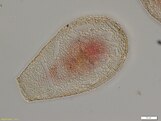- The following is an archived discussion of the DYK nomination of the article below. Please do not modify this page. Subsequent comments should be made on the appropriate discussion page (such as this nomination's talk page, the article's talk page or Wikipedia talk:Did you know), unless there is consensus to re-open the discussion at this page. No further edits should be made to this page.
The result was: promoted by PrimalMustelid talk 19:50, 18 November 2023 (UTC)
| DYK toolbox |
|---|
Hyalospheniidae

Planocarina marginata, a hyalospheniid amoeba
- ... that many hyalospheniid amoebae construct shells by stealing mineralized particles from the shells of their prey? Source: The Phanerozoic diversification of silica-cycling testate amoebae and its possible links to changes in terrestrial ecosystems
- Reviewed:
Improved to Good Article status by Snoteleks (talk). Self-nominated at 08:54, 20 October 2023 (UTC). Post-promotion hook changes for this nom will be logged at Template talk:Did you know nominations/Hyalospheniidae; consider watching this nomination, if it is successful, until the hook appears on the Main Page.
General eligibility:
- New enough:

- Long enough:

- Other problems:

Policy compliance:
- Adequate sourcing:

- Neutral:

- Free of copyright violations, plagiarism, and close paraphrasing:

- Other problems:

Hook eligibility:
- Cited:

- Interesting:

- Other problems:

| Image: Image is freely licensed, used in the article, and clear at 100px. |
|---|
|
| QPQ: Done. |
Overall: ![]() QPQ not necessary, article recently promoted to GA within time-frame. Images rights appear to be in order. Earwig and spot checks reveal nothing exciting.
QPQ not necessary, article recently promoted to GA within time-frame. Images rights appear to be in order. Earwig and spot checks reveal nothing exciting.
- The orginal citation states,
generally include a proteinaceous matrix in which mineral elements are embedded, either self-secreted (Euglypha, Quadrulella, Lesquereusia), taken from the surrounding environment (Centropyxis, Difflugia) or from prey organisms (Nebela, Padaungiella, Apodera).
- The page states,
Kleptosquamy, the ability of hyalosphenid amoebae to "steal" test scales from their prey, euglyphid amoebae, is hypothesized to be an ancestral trait within the family.
- However, the source 'The Phanerozoic diversification of silica-cycling testate amoebae and its possible links to changes in terrestrial ecosystems' states:
Hyalosphenids, a group within arcellinids, are predators of euglyphids. We demonstrate that hyalosphenids can construct shells using silica scales mineralized by the euglyphids. Parsimony analyses of the current hyalosphenid phylogeny indicate that the ability to “steal” euglyphid scales is most likely ancestral in hyalosphenids
, which is more direct to the DYK claim.